Services on Demand
Journal
Article
Indicators
-
 Cited by SciELO
Cited by SciELO -
 Access statistics
Access statistics
Related links
-
 Cited by Google
Cited by Google -
 Similars in
SciELO
Similars in
SciELO -
 Similars in Google
Similars in Google
Share
Revista Facultad de Ingeniería Universidad de Antioquia
Print version ISSN 0120-6230On-line version ISSN 2422-2844
Rev.fac.ing.univ. Antioquia vol.38 no.1 Medellín Jan./Jun. 2006
Pyrometer at low radiation for measuring the forehead skin temperature
Gianni Pezzotti a,* Paolo Coppa b , Fabrizio Liberati c
a Crystallographic Institute of the Italian National Research Council - CNR and Biosensor srl company, Rome, Italy.
b Dept. of Mechanical Engineering of the University of Rome “Tor Vergata”, Rome, Italy.
c Optoservices srl Company, Capagnano, Rome, Italy.
(Recibido el 30 de noviembre de 2005. Aceptado el 15 de mayo de 2006)
Abstract
This paper presents the results of the design, construction, calibration and tests of a low radiation pyrometer for temperature measurement of the human body. The instrument is based on a low cost thermopile as detector and an optical system. It is specially designed to measure the forehead temperature of a person. It is useful in applications like: Measurement of temperature of people in the airports (to prevent contamination with contagious diseases infection) or applications in medicine as continuous monitoring of the temperature of patients in intensive care units at hospitals. The instrument has been calibrated using an on-purpose-built black body and its precision is of 0.19 oC.
---------- Key words: low radiation pyrometer, thermopile, optical system, skin temperature
Pirómetro a baja radiación para la medición de la temperatura en la frente humana
Resumen
Este artículo presenta el diseño, construcción, calibración y desempeño de un pirómetro de radiación para la determinación de la temperatura del cuerpo humano. El equipo se basa en un detector de bajo costo y un sistema óptico. Está especialmente diseñado para medir la temperatura de la frente de una persona. Puede aplicarse para determinar la temperatura corporal de viajeros en un aeropuerto (a fin de detectar posibles portadores de enfermedades contagiosas), o en aplicaciones médicas tales como el monitoreo de pacientes en las unidades de cuidado intensivo de los hospitales. El instrumento se calibró con un cuerpo negro construido específicamente para este propósito; se encontró que la precisión del instrumento es de 0,19 ºC.
---------- Palabras clave: pirómetro de baja radiación, termo pila, sistema óptico, temperatura de la piel.
Introduction
One of the first applications of thermometry was the human body temperature measurement, and still today our idea of temperature measurement is related to the fever control with contact mercury in glass thermometers. These instruments are widely used, safe (even if environment contamination with mercury in the case of breaking is possible), accurate ( 0.1 ºC as standard uncertainty) and easy to use. Unfortunately they require insertion of the instrument, and their response time is quite long (3-5 min). This is the reason why in the last years ear thermometers appeared on the market (e. g. Braun IRT 3520). They are low temperature pyrometers using thermopiles as detectors, which measure the internal temperature of the ear, considering this cavity a black body isothermal with the inside of the human body. Their response is much quicker (about 1 s) and accuracy is considered comparable with the glass thermometers.
Even if these instruments can be considered quasi non invasive, measurements are carried on by leaning them on the ear. So some kinds of applications cannot be realized, as for example: continuous monitoring of the body temperature of ill people lying in beds (e. g. in recovery departments of hospitals), temperature measurements of people crossing gates in airports, for discovering possible infection of dangerous micro organisms (EBOLA, SARS, etc.), monitoring temperature of people in closed ambient for climate regulations [1-2].
The forehead is the external part of human body with a more constant temperature, almost independent on the environment temperature [3], and generally it is also an easy accessible part of the body, being its skin bare. Moreover skin can be considered a very good approximation of a black body in the wavelength range 1-10 μ m and radiant temperature measurements don’t require correction for emissivity.
Goal of the present work has been the design, construction, calibration and tests of a low temperature pyrometer able to measure human forehead temperature. Peculiar characteristics of the instrument are small sizes, easiness to use, low cost (at least in mass production), easy construction and quite good accuracy (about 0.1 ºC) in the skin temperature range (25-40 ºC).
Low temperature pyrometers are common on the market products (e.g. Minolta-Land Infrared, Ircon, Omega, etc.), but they generally use liquid nitrogen cooled sensors (or thermoelectrically cooled) and germanium lenses, and their cost results quite high, at least for a large number and wide use.
In order to fulfil the requirements desired for the described applications, it has been decided to build an instrument with the following features: reduced dimensions 60 mm wide and long), wavelength range between 3 and 15 m to get results in the desired temperature range, target area of about 2 x 2 cm enough high to give a detectable signal and enough low to guarantee a good focusing on the forehead, working distance between 350 and 400 mmand detected temperature range between 30 and 40 ºC.
Interesting features are presented by the instruments. The optical system is a single mirror, aspherical (elliptic) in order to minimize spherical aberration. Material is aluminium, in order to machine it with sufficient accuracy to reflect the radiation in the requested wavelength range, and gold coated to protect it and assure maximum reflectivity. Even if the prototype has been accurately machined, a mass production of the instrument can be imagined through plastic moulding with a large decrease of cost.
Optical System
The optical system is designed to convey the maximum radiant flux to the sensor. It consists of a single aspherical mirror, as already said. Optical design is based upon the following requirements: mirror diameter 50 mm, focal distance 375 mm and magnification 0.1 (in order to get an image of 2 x 2 mm, equal to the sensor area, from a target of 20 x 20 mm). Figure 1 Shows the optical design of the system.
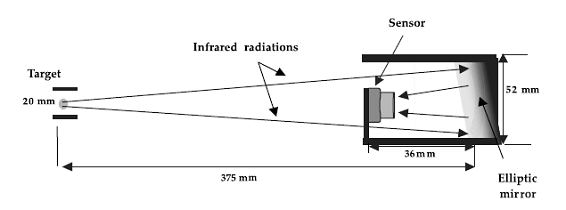
Figure 1 The optical design of the system
Such optical system allows minimize optical aberrations. Chromatic aberration is not present being the system a mirror. Spherical aberration is reduced through the use of an elliptic profile: the detector is located in one focus of the ellipsis while the source (forehead skin) in the other (figure 2). Besides, such system doesn’t require the use of baffles to reduce stray radiation. Coma and astigmatism are not present being the main rays on axis.
When the focusing distance ranges between 350 and 400 mm, target area increases from 20 x 20 mm to 25 x25 mm, still acceptable for the identified applications.
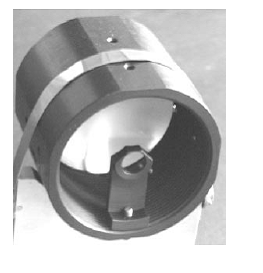
Figure 2 Optical system
Characteristics of the mirror
The principal characteristic of the mirror are the shape and the material: the elliptic concave mirror is made of aluminium, with reflecting surface coated with gold (figure 3) to avoid oxidation and increase reflectance of radiation in the wavelength range corresponding to 20-45 °C. The same wavelength range does not require a too high superficial finishing, but the one obtainable with a good machining (about 0.5 m) is sufficient.
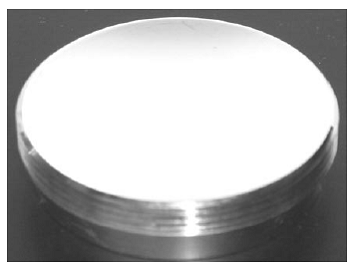
Figure 3 photo of the aspheric mirror
Mechanical system
The mechanical system is designed to support the mirror and the detector at the locations foreseen by the optical design. It is a cylindrical tube, with the inner surface machined (milled with a 1.5 mm step threading) in order to reduce as much as possible stray radiation (ambient light from outside reaching the detector). The mechanical design is reported in figure 4. Internal and external surfaces of the tube are blackened (matt black anodizing).
On the external surface of the tube four grabs are located to allow mounting of the instrument on a bed (in hospitals) or in a gate (in airports).
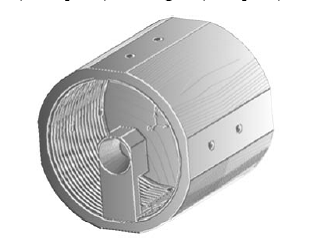
Figure 4 View of the mechanical system
Radiation sensor
Among the several detectors usable in the desired wavelength range, thermopiles have been chosen due to their good performance (D* = 5*10-5), low cost (can reach US$5 per piece in mass production), easiness to use, because they don’t require cryogenic cooling. The only drawbacks are the response time not too short, about 0.3 s, but anyway enough adequate for most of the identified applications, and the necessity of cold junctions compensation. In fact these devices give a signal influenced not only by the target temperature, but also by the ambient temperature (in the same way as thermocouples), generally measured by a thermistor inserted into the thermopile case. In the present use, anyway, this cold junction compensation can be carried out during the pyrometer calibration. Two types of thermopiles have been tested and used (from two different producers, Cal Sensor and Melexis). Features of the two devices are reported in table 1. The two sensors are depicted in figure 5.
The Melexis TP is also supplied with a module for automatic compensation of ambient temperature and supplying the target temperature values.
Table 1 Feature of the thermopiles

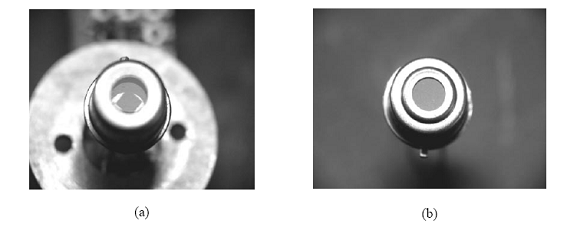
Figure 5 Photo of the two thermopiles used: a) Cal Sensor; b) Melexis
Calibration of the thermopile
Before inserting the two types of thermopile into the instrument, they have been individually calibrated to recognize the dependence of the signal on the target temperature (calibration of direct sensitivity), and the one on the ambient temperature (calibration of cross sensitivity).
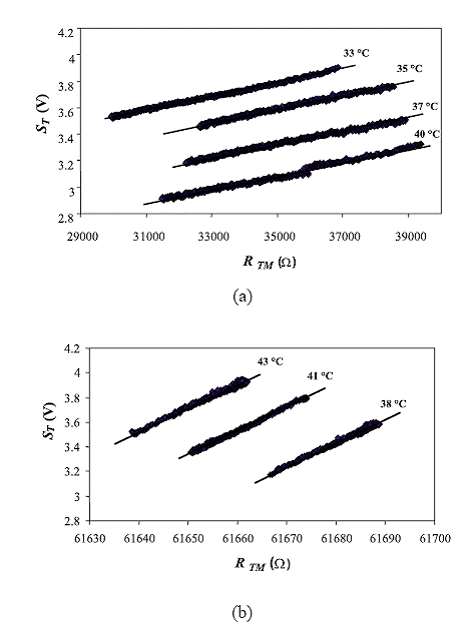
Figure 6 Direct and cross calibration of the Call Sensors a) and Melexis b) thermopiles Behaviours of the output signal versus the ambient temperature (in abscissa, given by the thermistor resistance, in ) and the black body temperature, in °C
These tests have been carried out by aiming the thermopiles on an extended blackbody at a fixed temperature, while the ambient temperature was changing by regulating the heating plant of the laboratory, or the air conditioning. Figures 6 a and b report the results of this calibration. Instead of the ambient temperature, the thermistor resistance, in , is reported on the abscissa.
Calibration of the pyrometer
When inserted into the instrument, the thermopile is influenced by the ambient temperature not only because of the cold junction temperature, but also for other two reason: first because the field of view (FOV) is wider than the angle subtended from the detector to the mirror, and second
because the reflectivity of the mirror is surely quite high (0.95-0.98) due to the gold coating, but not unitary, and can degrade for powder contamination and oxidation. As a result, these three phenomena contribute to the dependence of the output signal on the ambient temperature, and can be taken into account by an overall calibration. Again this calibration is carried out by changing both the ambient and the source (black body) temperature, where the pyrometer is focused.
Figure 7 reports the results of these tests. Here on the abscissa, the blackbody temperature is reported, and different curves are related to different ambient temperatures. A parabolic behaviour of the signal vs. black body temperature is recognizable, while a linear behaviour vs. ambient temperature is present (in the same way as in figure 7). Processing of these data is possible by means of a multiple linear regression between the dependent variable, the pyrometer signal Spyr, and the two independent variable, the black body temperature tbb and the thermistor resistance, Rtm, function of the ambient temperature. The regression model is described by the following equation:

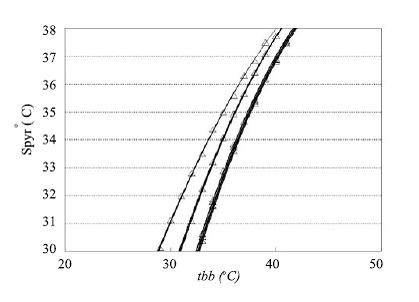
Figure 7 Pyrometer calibration: recorded pyrometer data vs. ambient temperatures and black body temperatures, and regression lines
The best approximation of the unknown [4] is reported in table 2 with their standard uncertainties; the relative behaviours are shown on figure7. A final prevision uncertainty of the least square algorithm was 0.081 V.
When the pyrometer is focused on a target (human forehead), in order to get its temperature, eq.1 must be inverted:

The standard uncertainty of these values, obtained from the prevision standard uncertainty of the eq. (1) regression with the uncertainty propagation law, resulted about 0.15 ºC. This value can be seen the calibration uncertainty of the evaluated temperature (type B uncertainty, according to the GUM [5]).
Table 2 Result of the least square regression of recorded data, using eq. (1) as model
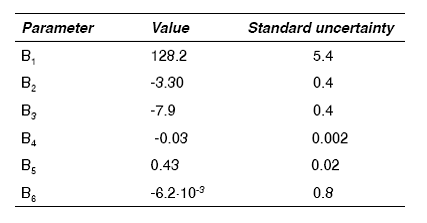
Preliminary tests on the pyrometer for measuring the forehead skin temperature
A series of tests have been carried out focusing the pyrometer on the forehead of several people (about 10), and changing the working distance from 350 mm to 400 mm. All the detected values ranged between 34 and 34.5 ºC, confirming that the forehead temperature is almost constant among different people, and depends only on ambient parameters (e.g. air temperature, wind, mean radiant temperature, relative humidity, according to Fanger theory of human comfort [6]. Figure 8 reports a typical test.
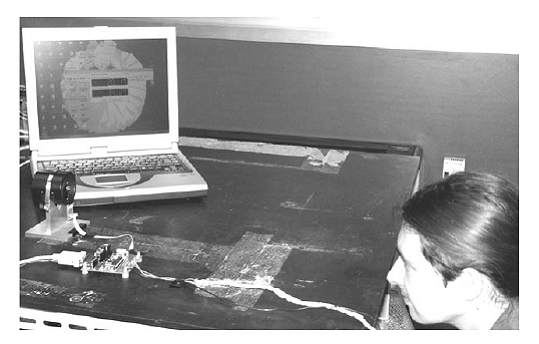
Figure 8 Typical test: measurement of forehead temperature
Uncertainty analysis
As already said, least square regression gives an uncertainty value of 0.15 oC (calibration uncertainty). Repeated measurements gave results in a 0.1 oC range, so a standard uncertainty of 0.05 can be attributed, as type A uncertainty [5]. Other uncertainty sources (type B) could be:
Effect of ambient temperature: in the calibration it was assumed that the detector case (ie. the cold junction), the mirror and the pyrometer body were all at the same temperature. It is likely that this can be true, due to small sizes of the instrument, and its material (aluminium). Anyway a maximum difference of about 0.1 °C can be imagined between different instrument components. This difference contributes only for a negligible amount to the total uncertainty.
Effect of ambient light: negligible effect was noticed due to the presence and intensity of day light or artificial illumination during the night.
Contamination of the mirror: laboratory tests have been carried out with the unprotected mirror. After one year the mirror became a little opaque, and it was necessary to clean it. A protection with SiO or MgO thin layer should reduce the problem, and allow a safer and easier cleaning.
Finally a total standard uncertainty of 0.19 ºC can be ascribed to the instrument.
Conclusions
The instrument was proven to be able to give the forehead temperature with an accuracy better than0.2 ºC, without contact, and with a working distance between 350 and 400mm.
The prototype of the instrument is light (only 0.2 kg in weight), easy to use and to mount on beds or gate for sanitary applications (control of fever of people lying in beds or passing through airport gates; to prevent contamination of dangerous infection, as EBOLA or SARS). Other applications are easy to find, if requirements are fulfilled by the instrument features: i.e. working distance between 350 and 400 mm, target area from 20 x 20 to 25 to 25 mm, temperature range between 30 and 45 ºC. If the emissivity is different from unit (black body), than its value must be known in the wavelength range used for the measurement (i. e. 1 12 m) to properly correct readings.
Industrialization of the instruments is still necessary to get a device portable, reliable, without problem of contamination of the mirror from powder and pollution. This could be done by a vacuum deposition of a thin layer of SiO or MgO on the mirror. If the working distance of the pyrometer should be changed in order to meet different requirements, a proper new optical design (similar to the one shown in the present paper) should be provided.
Acknowledgements
The authors grateful to FIAT Centre of Research and Faculty of Engineering of University of Rome “Tor Vergata” for providing funds and for suggesting the research project. The instrument presented have been developed in Heat Transfer and Thermal Laboratory. Faculty of Engineering. Patent RM2004A000528.
References
1. Y. Taniguchi, H. Aoki, K. Fujikake, H. Tanaka, M. Kitada. “Study on Car Air Conditioning System Controlled by Car Occupants’ Skin Temperature – Part 1: Research on Methods of Quantitative Evaluation of Car Occupants Thermal Sensation by Skin Temperatures”. SAE Paper n. 920169. 1992. [ Links ]
2. H. M. Lee, Ch. K. Cho, M. H. Yun, M. W. Lee. “Development of a Skin Temperature Control Prodecure for a Romm Airconditiones Using the Concept of Just Noticeable Difference (JND) in Thermal Sensation”. Industrial Ergonomics. Vol. 22. 1998. pp. 207-216. [ Links ]
3. H. Kataoka, H. Kano, H. Yoshida, A. Saijo, M. Yasuda, M. Osudi. “Development of a Skin Temperature measuring system for noncontact stress evaluation”. Proc. of the 20th International Annual Intern. Conf of The IEEE Engineering in Medicine and Biology Society. Vol. 20. 1998. pp. 940-943. [ Links ]
4. S. Brandt. Statistical and Computational methods in Data Analysis.North Holland Pub.Amsterdam. 1970. pp. 55-67. [ Links ]
5. ISO. Guide to the Expression of Uncertainty in Measurement (GUM), (1995) [ Links ]
6. P.O. Fanger. Thermal Comfort. McGraw Hill. New york. 1973. pp. 173 -194. [ Links ]
* Autor de correspondencia. Teléfono: 39+335+664 01 34, fax: 39+06+90672704, correo electrónico: gianni.pezzotti@uniroma2.it, g.pezzotti@biosensor.it














